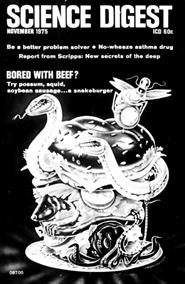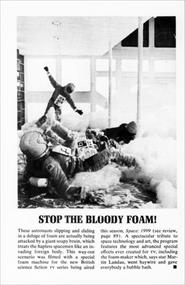Criticism
Space: 1999 Adventures in Science "Faction"
by Arielle Emmett

Science Digest Volume 78 issue 5 (November 1975) pp 89-92
Science Digest was a monthly science magazine published by Hearst, from 1937 to 1988, aimed at general readers (a sort of "Readers Digest" for science).




MOST GOOD SCIENCE FICTION today isn't science fiction at all, but a wedding of science fact and imagination sprinkled with human foibles. Call it "science faction," if you will, as does Brian Johnson, the special effects man behind TV's fall highlight, Space: 1999. The key to the new genre is its striking adherence to science in our own backyards - Cape Canaveral, Los Alamos, Soyuz, Mayo Medical Center - and to the fantastic possibilities our science holds.
Space: 1999 is the newest, most spectacular and expensive (six and a half million dollars for 24 episodes) tribute to science faction ever produced for television. Starring TV's handsome acting team, Martin Landau and Barbara Bain, and produced for Independent Television Corporation by Britain's sci-fi wizards, Gerry and Sylvia Anderson, Space: 1999 is a visually stunning, space-age morality play that chronicles the downfall of 20th-Century technological man.
Perhaps not a fitting theme for entertainment at first glance, but the producers gambled that TV viewers would rather see themselves 24 years from now than in several thousand, when there is probably no "future" for us at all. What the Andersons and Brian Johnson envisioned was an imaginative, often plausible extension of present-day reality: a Moonbase Alpha that is modular and solar-powered, similar to the space colonies proposed by futurists like Gerard O'Neill of Princeton; a nuclear waste disposal accident, forewarned already by physicists the world over; and the forced search and colonization of a new planet, one alternative proposed by scientists for man once he's finished with earth.
Says Brian Johnson, who also supervised special effects for Stanley Kubrick's 2001: "Like any science fiction series, one starts off with high ideals about everything having to be as near scientifically accurate as possible until one reaches a point where science fact becomes slightly boring and science 'faction' takes over. Whether or not a forcefield would work against a black hole; or that time warps stand out as being plausible or not, does not matter. I've noticed that astronomers squabble over various ideas, and have squabbled for generations... The prime concern of any film maker is to entertain."
And that they do. The producers have created a scenario that is real enough to be scary, just fantastic enough to capture our interest. A chain reaction of radioactive nuclear waste pulverises mankind's newest garbage dump, the dark side of the moon, and catapults the light side and its 311 earthly inhabitants on Moonbase Alpha out of earth's orbit forever. "I come up to troubleshoot and a launch a probe," says Martin Landau, who identifies so strongly with his character, Commander Koenig, that he sometimes confuses the two, "and before I become effective in stopping the waste disposal it blows up, and off we go... We have no control over trajectory and can barely survive. The last contact with earth is a radio flash of earthquakes and tidal waves... We don't even know if the earth exists anymore..."
The story is not too far-fetched. Numerous journals, including Physics Today and the Bulletin of Atomic Scientists, have recently warned of catastrophic nuclear accidents, asserting that the detonation of only ten kilograms of plutonium, with an efficiency of one tenth of one percent, would still amount to the equivalent of 200 tons of TNT. That is enough to blow an entire city - if not a small planet - off the celestial map.
The survivors on Moonbase Alpha, led by Koenig, a former Apollo astronaut, a ship's physician (Bain), and an O'Neill-like space scientist (Barry Morse), try to keep body and spirit together as they bite and claw their way to survival against the most deadly forces of the universe - time, mortality, antimatter, and civilizations more primitive and more advanced than our own. "Technologically and emotionally we shouldn't be out there," remarked Landau in a recent interview with Science Digest. Producer Gerry Anderson adds: "We have been careful (unlike Star Trek) to ensure that the people of earth are not a super race." Unable to even procreate on the Moonbase due to limitations in the life-support system, the Alphans search in each weekly fly-by for a planet on which to settle and begin anew. the mathematical (if not theatrical) odds are with them: recent estimates by the Rand corporation indicate that there are 600 million planets suitable for human habitation in this galaxy alone.
Producing such a tale of technological booby-trapping is like a good science faction story itself. Brian Johnson, confronted with the task of creating a believable set for the the Moonbase, each exterior planet surface, and every other imaginable intergalactic phenomenon (flaming supernovas, black holes, etc.), opted for a fusion of science and art; combining the most fantastical techniques of film-making and set design with images inspired by the newest developments in avionics and space-age architecture. "I envisaged the Alpha Moonbase to be modular in construction," he said. "The method of travel was defined as a series of high-speed subway links, using a vehicle of a type which resembled more of a lift than a wheeled structure. The modular transport unit, which then became known as 'Eagle' [pictured on page 90], came in a series of very quick doodles on a piece of paper, occupying a time factor of about 25 minutes. I had in my mind's eye an insect-like appearance, as the majority of interesting space and earth-flying vehicles are decidedly insect-like, vis-a-vis Concorde, Viking, and many others...I also envisaged a large technical area dealing with the servicing of Alpha Moonbase and the Eagles, with the possibility that 40 to 50 Eagles would be in service in the command area."
Two years ago Johnson constructed Moonbase Alpha in the cavernous spaces of Pinewood studios in England. He came up with a 17-unit structure built with interchangeable parts like a "giant Lego set"; which could be reshuffled for maximum believability. The scripts for each episode were broken down into distinct sci-fi sequences, and then conceptualized visually on story-boards. The technical team fashioned and tested all the models and gadgets needed to produce optical effects for each episode well in advance; all special effects sequences were shot in a separate studio containing front and rear projection screens and high pattern fibre optic devices, and then transmitted as a series of sketches to Pinewood via Rank Xerox Telecopier. The crew took about four shots per day, mostly in multiple exposure, and then "optically married" (as Johnson calls it) the half-completed sequences at a later date. The film camera, a standard 35mm Mitchell high-speed, was linked to a television monitor system which synchronized live or video tape pictures with the cameras shutter; preventing the characteristic "roll" that one is accustomed to seeing when television pictures are recorded on film.
That Space: 1999 is a brilliant piece of 20th-Century technological art, film-making, is readily evident at a glance. What is perhaps less obvious is that the producers are using technology and art to talk about other issues. This is the essence of science faction: "that we can humanize the spaceman so that we can identify with him," says Landau, "and at the same time touch base with something mindblowing." After all, technology is not a dirty word. It has the capacity to cure and to maim, to entertain and even moralize. Concludes Gerry Anderson: "The problem is not to do with technology but human nature, and in our series we try to deal first and foremost with this, for therein lies the solution."
Arielle Emmett is Assistant Editor of Science Digest.
Page 90 Photo Caption: Johnson's modular transport unit, a fusion of space and art: Decidedly bug-like.
Page 91 Photo Caption: Trapped by technology in a vision of tomorrow, Martin Landau stares down at an alien he never wanted to see.

These astronauts slipping and sliding in a deluge of foam are actually being attacked by a giant soapy brain, which treats the hapless spacemen like an invading foreign body. This way-out scenario was filmed with a special foam machine for the new British science fiction TV series being aired this season, Space: 1999 (see review page 89). A spectacular tribute to space technology and art, the program features the most advanced special effects ever created for TV; including the foam-maker which, says star Martin Landau, went haywire and gave everybody a bubble bath.
Thanks to Bill Adkins, Allen Barnella